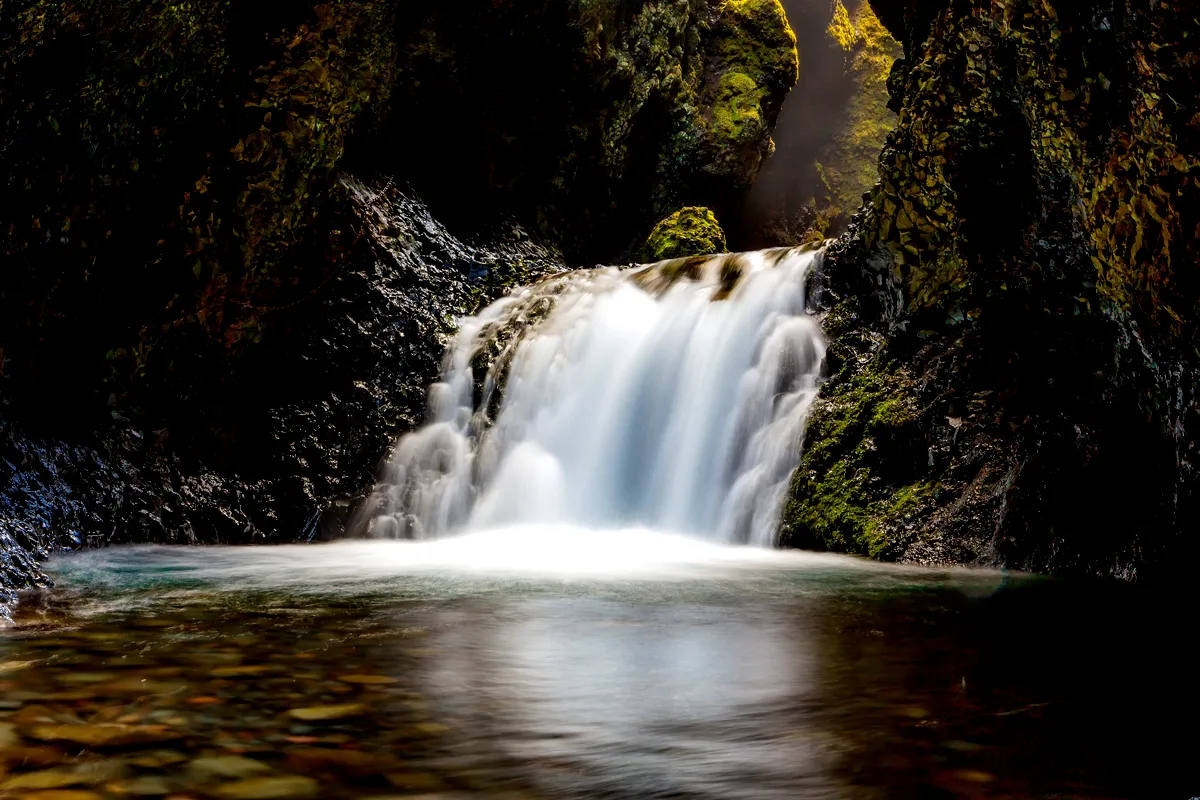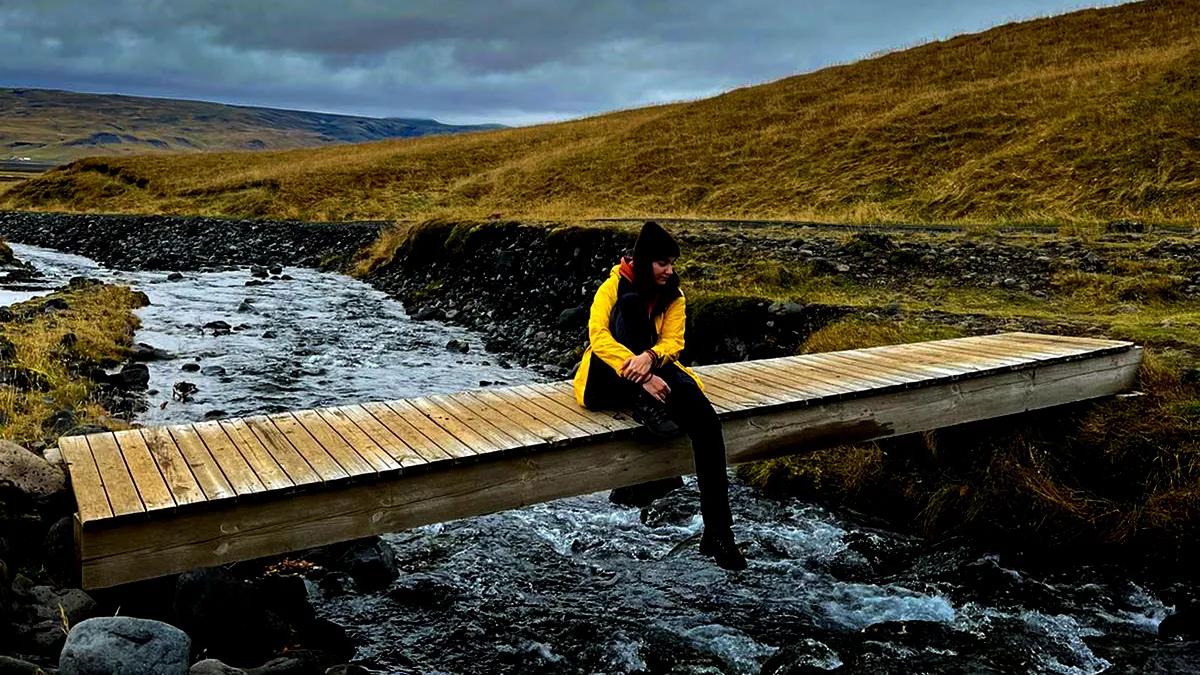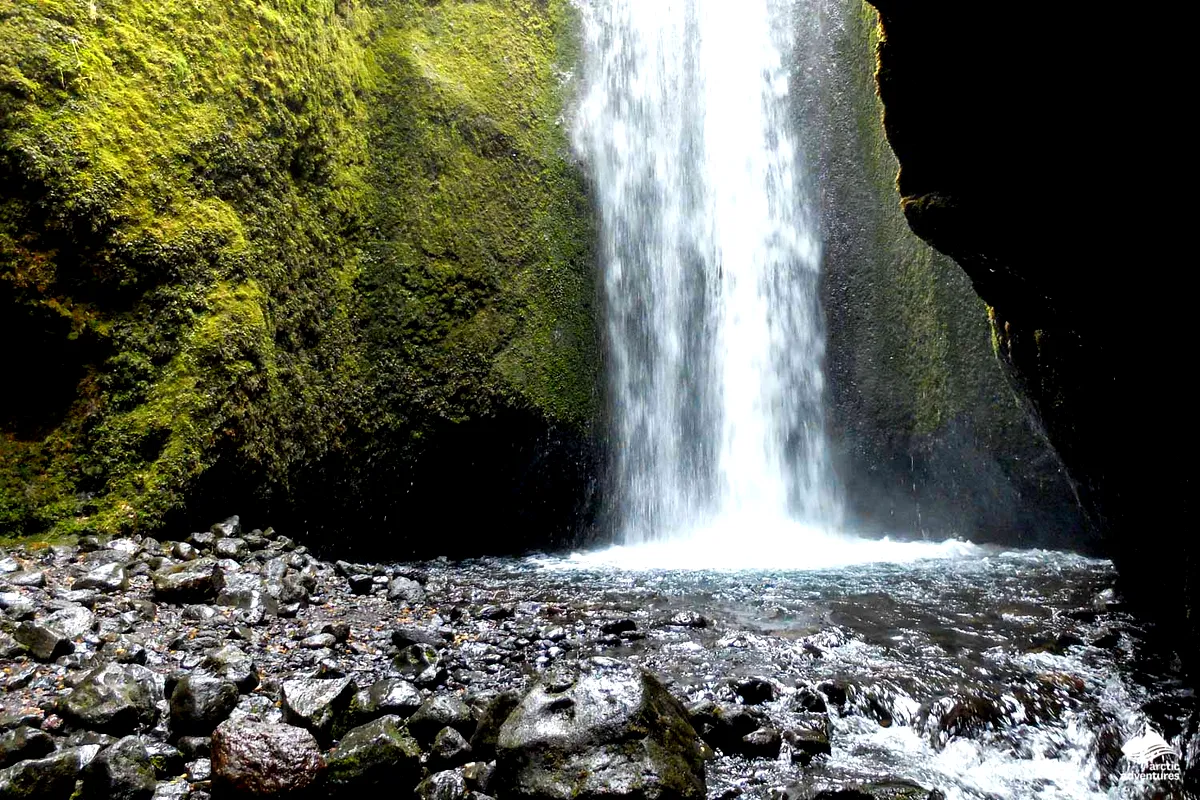The number of hidden gems in Iceland is shrinking by the year. Semi-hidden gems like Nauthúsagil are a good way to get off the beaten path without wasting time and effort. This particular part of Iceland carries a dark legend and a fairytale hike.
In this article, we cover everything from Nauthúsagil Lore to practical tips. Read on to learn all you need to know about visiting the legendary gem of Nauthúsagil.
The Name Nauthúsagil and Where it Comes From
Most of the time, we’re not very bothered with how certain places get their names. In the case of Nauthúsagil, it has a little bit of a discourse, which makes the name situation interesting. The name “Nauthúsagil” means “Bull Shed Ravine,” which makes perfect sense if you hear the first story.
A few hundred years ago, the nearby farm, Stora Mörk Farm, built a shed for various livestock not kept for milking purposes – bulls, for example. This shed was placed right at the beginning of the Nauthúsagil Ravine, which might allude to why it is believed that this particular shed is the reason behind the name of the area.

Another theory is that the name comes from another farm that was built not far away from the ravine, which is named Nauthús – meaning “Bull House”. Some claim that this farm is the actual origin of the name of the area. This is a little bit of a “chicken and egg”-controversy since there aren’t any records to prove which one came first – the farm or the name of the area.
To quote Timon in the classic song Hakuna Matata: “Oh, what’s in a name?”. In this particular case, the controversy is strong for some reason, and people all over Iceland are picking sides and are willing to get into heated debates about it. The only thing we know for sure is that the area was popular for raising beef, and the locals loved their beef so much that they named the area after it, one way or the other.

The Legend of Nauthúsagil and Spectral Turmoil
On the farm Nauthús, an unfortunate family drama took place. The latest inhabitants on the farm were three brothers and a sister who lived there in the early 1700s. Two of the brothers killed the third brother in cold blood, and like a sensible woman, the sister ran away to a nearby farm where she married into the family there instead. They were probably much less prone to murder.
The two wicked brothers obviously didn’t like this and decided to keep to their murderous ways and tried to kill their sister’s new husband. Unfortunately for them, the husband managed to overpower and kill both of them before they could carry out their plan, so naturally, the brothers’ spirits haunted the area and made life miserable for everyone involved.

The farmer, who had already gotten rid of them once, hatched a clever plan and managed to trap one of the wicked ghost brothers in the local church. Unfortunately, that only made the other ghost brother angry, and the Nauthúsagil area became plagued by this spirit with a vengeance.
The haunting only stopped when the Nauthús Farm was abandoned in 1770, but some people claim to have been haunted by the ghost brother when they explored the farm. If you are interested in this sort of thing, a brief visit (preferably in daylight) in this part of Nauthúsagil might be for you.

What Makes Nauthúsagil So Special?
Apart from ghosts and controversy regarding the naming of the area, Nauthúsagil is an incredibly beautiful place with a unique landscape. The main attraction of the area is the Nauthúsagil Canyon, with a gorgeous view on one end and a stunning waterfall on the other.
Nauthúsagil Canyon
Some people claim that the journey can be the goal, and in the case of Nauthúsagil, we are inclined to agree. Nauthúsagil is famous for the canyon and the unique elements in it, and it’s easy to understand why when you enter the canyon and start following the flow of water upstream.
The rock composition of the canyon lies in layers of soft tuff at the bottom to hard lava rock at the top. This means the canyon is more hollowed out at the bottom than the top since the stream has eroded the bottom layer more than the top. This phenomenon creates a sensation that the walls of the canyon almost lean inward at the top, so it feels a little bit like walking a long corridor rather than a canyon.

The Nauthúsagil Canyon Flora
This feeling is only enhanced by the overhanging Rowan bushes that grow along the sides of the Nauthúsagil Canyon at the top. In the summer in Iceland, you will have a few sections of the canyon almost completely covered by these lush branches that give a green “roof”. Rowan is a type of tree that likes the acidic ground created by volcanic ash. Incidentally, Rowan is also known as the “Bane of Witches,” so it will keep the evil ghost brother away from you on your hike.
In the winter in Iceland, the same branches that gave a calming green presence will instead be heavy with snow and feel slightly more ominous. If you are a fan of the dark and mysterious, snapping pictures along the canyon from the inside is probably a good idea.
Nauthúsagil Waterfall
The crown jewel of the Nauthúsagil Canyon is the waterfall at the end of the hike. The long river that runs through the canyon is not a big and powerful story, but the waterfall is still impressive. The walls are completely covered in moss and algae because of the waterfall’s long drop down the cliffs, and the small pool at the bottom shifts from a blue-green hue at the center of the pool to a crystal-clear stream as it continues its journey.
The Nauthúsagil Hike
To reach the Nauthúsagil Waterfall, you must first hike to the canyon and then choose if you want to go through the canyon or around it. The path to the beginning of the canyon is roughly 550 meters from the parking lot and follows the eastern side of the stream. Once you get to the mouth of the Nauthúsagil Canyon, you can move into the ravine and continue along the river or stay on the top side until you reach the waterfall.
If you go along the river inside the canyon, you should prepare to get wet, so dress accordingly. You will need to cross the water at least twice and climb next to a 2-3-meter-tall waterfall about halfway through. Even though the stream isn’t very strong, it’s recommended for small children and seniors to rather take the path around the gorge.
The hiking path that goes around the Nauthúsagil Canyon is an easy affair and is more of a walk up a hill than anything else. Just remember to stay on the path and not walk close to the edge of the canyon to avoid any accidents. This path won’t provide the same type of unique scenery, but it allows you to continue further after the Nauthúsagil Waterfall to an even larger one up the mountainside.
The hike is relatively short, even if it takes some time to complete due to the slippery terrain. In the peak season, you might even have to queue a little bit when passing the first waterfall and some other spots along the way. On the other hand, if you walk along the top, you won’t have to queue at all since it is all open field.
When is the Best Time to Visit Nauthúsagil?
The best time to visit Nauthúsagil is going to 100% be based on your own preference. Different times of the year will provide different sceneries and opportunities.
Generally, the summer in Iceland is a great time to visit since you get good access to the entire canyon, the weather will be nice and mild, and the ground will hopefully not be too wet or slippery. The river will be pretty low, and you won’t risk frostbite if you get your tippy-toes wet.
The shoulder seasons of spring and fall in Iceland will be the best bet for the ones who want to see the river in Nauthúsagil come down with more force. In the Icelandic Spring, the meltwater from the mountain comes rushing down. And in the fall, the increased precipitation will fill up the river like a hose in a garden.
The winter is the best time of the year to experience the desolate part of the Icelandic landscape since the fields will be empty and the snow will (hopefully) cover the ground.
Where is Nauthúsagil?
Even though there are few things as scary as ghosts, Nauthúsagil is the home of yet another terrifying entity. The canyon is located on the far western side of the Eyjafjallajökull Volcano in the southern part of Iceland. It is one of the more active volcanoes in Iceland and has been causing some trouble in the 21st century.
How Do I Get to Nauthúsagil?
Unless you’re up for a very long walk along the Icelandic Roads, the only way of getting to Nauthúsagil will be either by joining a tour or driving yourself.
Tour
Since Nauthúsagil is still a little bit of a hidden gem, most tours have this as one of many stops on a day tour to Thorsmörk National Park. These tours will usually depart early from Reykjavik and take between 8 and 10 hours.
Self-drive
As avid adventurers, we always prefer to drive our own transport whenever we go on trips around our beloved island. The drive to Nauthúsagil is an easy one and usually doesn’t take more than 2 hours to drive from Reykjavik. If you make stops along the way (which is highly recommended), it will take a little longer, but such is the nature of an adventure.
To get to Nauthúsagil from Reykjavik, drive along the Ring Road, heading east for about 125 kilometers before you turn left (or north if you prefer that terminology) on Road 249 towards Thorsmörk. The turnoff is the same as for Selljalandsfoss Waterfall, so that is one of the natural stops to make on the way there or back. From the turnoff, just follow Road 249 until you reach Stora Mörk Farm and stop by the parking lot there.
What to Expect at Nauthúsagil
When you arrive at the parking lot, you’ll immediately see that this is not the usual tourist spot, so there are no amenities or shops. This is just a traditional Icelandic gravel parking lot.
Since Nauthúsagil is starting to become more and more popular, you might struggle to find a good parking spot in the peak season. The best way to avoid this in the summer is to arrive early in the day or later in the afternoon. The Midnight Sun in Iceland will keep you company most hours of the day, so you don’t have to bring a flashlight if you decide to come a little early or late.
Here's a list of things you should pack on your trip:
- Sturdy hiking boots that can give you decent traction on the wet ground.
- A jacket that is somewhat wind- and waterproof.
- A backpack to keep your snacks, extra clothing, and drinks (you will be using both your hands a lot on the hike)
- At least one towel to keep yourself and your electronics dry.
Plan Your Best Nauthúsagil Visit
Nauthúsagil is one of the semi-hidden gems in Iceland that provides an unmatched experience for very little effort. It’s easy to find, and the hike is short, albeit a little difficult at times. If you drive yourself and plan on making this one of many stops on your Iceland adventure, you should rent a camper in Iceland.
Driving a motorhome gives you a lot of freedom, and you don’t have to deal with strict itineraries and rushing to check in at hotels or guesthouses. There are plenty of camping spots nearby Nauthúsagil, so a motorhome will give you peace of mind on your travels.

